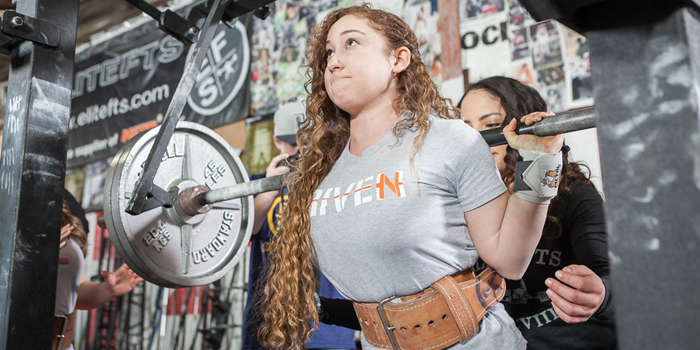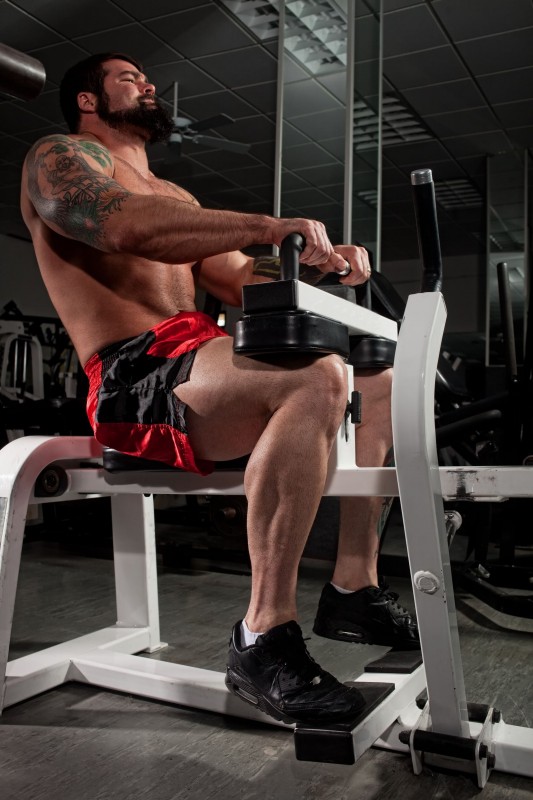
Why is it that calves are one of the hardest muscle groups to grow? People take all sorts of approaches to drive calf hypertrophy, but it seems that most of the time, those suckers (aka your calves) are pretty unresponsive. But why is that? Well, I’m not sure if there’s a general consensus out there as to why that is, but I am sure that we can take some time now to talk about the muscles of the calf and how we can merge scientific and applied information to improve your calf training workouts.
When we talk about the calf muscles, we are talking about the soleus and the gastrocnemius (gastro). Of the two, the most superficial (anatomical location) is the gastro, which has two heads and is shaped like a heart. The other calf muscle, the soleus, is much smaller and sits underneath the gastro. Both muscles work to help you plantar flex (aka movement of standing on your tippy toes). The gastro does this when your leg is straight, and the soleus can function when the leg is either bent or straight. The fiber type composition difference between the two makes the gastro more important for explosive movements and the soleus more important for stabilizing movements.
elitefts Customer Product Reviews — The Seated Calf/Tibia Raise Machine with TJ Slomka
In terms of fiber type composition, the gastro has more fast twitch fibers (Type II) than the soleus1. More specifically, the gastro is about 50% slow twitch and 50% fast twitch. Fast twitch fibers are the ones that contract with the most force and help you move fast. However, those are also the ones that fatigue the fastest. The soleus is mainly Type I, slow twitch, fibers and often thought of as a stabilizer muscle. The percentage of slow twitch fibers in the soleus is about 80%, meaning it is a muscle that is pretty fatigue resistant and great at high rep/long duration activities. Unfortunately for you and the soleus, its hidden location behind the gastro makes it hard to visualize its growth. However, don’t let its limited visibility and high fatigability distract you from training it hard. Every inch matters when it comes to growing those calves.
Practical Thoughts
Have you ever seen a sprinter? They have awesome calves, most of the time without having to directly train those suckers the way bodybuilders do. Since the gastro makes up most of your calf and is relatively high in its proportion of fast fibers, it kind of makes sense that people who train explosively often have great calf development. This observation touches on the idea that fiber-type specific training can help you grow your muscles more efficiently. This isn’t a new thought though, as many people believe that if you want fast fibers to grow, you need to train them explosively. We don’t really have many conclusive data out there to reject this idea, and there has been evidence to somewhat support it. A paperback in 20033 supported this idea (I know, I promised this was the practical section, but I just couldn't help myself) and demonstrated that strength athletes (i.e powerlifters, weightlifters) have a higher proportion of Type II fibers than bodybuilders2. At least to me, that kind of makes a lot of sense. Back when I was a strength and conditioning intern, I used to see different sports athletes have completely different levels of calf development, despite having a similar calf-training regime. The sprinters and running backs always had the most developed heart shaped calves; whereas, the cross-country runners and rowers always had the least heart shaped calves and the most developed soleus muscles.
MORE: Calves to Cows — 5 Methods to Improve Your Calf Development
Now, I’m not saying that to train your gastro you should only do explosive things and to train your soleus you should only do high rep things: that would be silly considering that 1) a given muscle has a mix of both fast and slow twitch fibers, 2) unless you were to take a biopsy, there is no non-invasive way to know the fiber composition of your calf muscles, and 3) the scientists still haven’t told us if Type I and II fibers respond better to a specific type of training. Instead, what I am saying is that it seems to me that there is probably some truth to the idea that fiber type specific programming can be beneficial. In my own personal experience, my calves always seem to get the best development when I was doing a lot of jumping and sprinting (box jumps, Olympic lifts, etc.). However, when I tried to train them using high reps, it always took a ton of volume and multiple training sessions per week (i.e. 5 sessions). In my own experience, those suckers seem to be pretty resistant to overtraining. But hey, that also makes sense considering that for loading to cause a calf adaptation, it has to be greater than the everyday damage they endure from us walking and running around on them.
Scientific Insight
In 20033 and 20042, Dr. Fry’s group showed that untrained people have less Type IIa fibers than powerlifters (~44 v. ~52%), and that their fiber type distribution is similar to that of bodybuilders. This kind of supports the idea that training to be explosive can cause some fiber type specific adaptation. This might be good news for those planning or already doing explosive exercises to target their calves. Since the calf muscles constantly undergo low levels of loading from walking and running, and since the muscle that makes up most of the calf’s size (the gastro) has a good amount of Type II fibers, it might be a good idea to target calf growth using explosive movements that overload the muscle. That being said, high rep movements that challenge the fatigability of the calf shouldn’t be forgotten, because Type I fibers can still grow too 4-6.
Now, let's throw another interesting consideration into the mix. When it comes to the process of making muscle grow, it comes down to a series of events: 1) you cause overload induced damage by lifting, which 2) wakes up the sleeping muscle stem cells, which 3) undergo the processes of activation, growth, replication, and differentiation, so that they can 4) fuse to the damaged fibers to help make them bigger and stronger. However, if the load you lift isn’t damaging the fiber, this process isn’t really going to occur. Interestingly, the muscle stem cell content is much higher in Type I fibers7, which is likely due to the fact that stabilizing muscles continuously have to handle more loads, and need more stem cells to help them constantly regenerate. Thus higher numbers of muscle stem cells in the calf, especially the soleus, may explain why it is so hard to overtrain this muscle group. So, to make both the soleus and the gastro grow you likely need to 1) overload them more than daily activities do, 2) target them with some explosive exercises, and 3) target them with some frequency.

3 Points of Consideration When Creating a Calf Workout
So how the heck do you make your calf muscles grow? Here are some suggestions.
1. Train for Explosiveness
At the beginning of a workout pick jumps, sprints, and/or Olympic lifts to target activation and damage to the fast fibers of those muscles. Although the gastro may benefit more from this, since it has a higher percentage of fast twitch fibers, this should benefit the growth of both muscles within the calf.
2. Train Heavy Straight Leg Calf Raises
Use straight leg calf raises in sets of ten until you hit a weight you can only do for 1-5 reps (targets strength), and then stay at that weight for 3-5 sets. This will help target the fast and slow fibers of the calves (thanks, Henneman's size principle). The use of the heavy sets will also overload the calf to induce more damage than it gets in daily life. Consider ending with a massive drop set or a few back off sets of 20+ reps to also target overloading and fatiguing the slow fibers of the calf that require significantly more volume to grow.
3. End or Start with Seated Calf Exercises
Use a seated calf exercise to exclusively target the soleus (the gastro doesn’t really function when the knee is bent). Since the soleus is rich in Type I fibers, use really high reps (think 15+ reps or sets of 60-90 seconds) for many sets (3-10). If placed at the beginning of the workout, this can help pre-fatigue the Type I fibers so that the Type II fibers really have to do some work when it comes to executing the rest of the workout. If placed at the end of the training session, when the Type II fibers are probably already tapped out, it can be a really potent finisher to target the energizer bunny Type I fibers.
References
- Edgerton, V.R., Smith, J.L. & Simpson, D.R. Muscle fibre type populations of human leg muscles. The Histochemical journal 7, 259-266 (1975).
- Fry, A.C. The role of resistance exercise intensity on muscle fibre adaptations. Sports medicine 34, 663-679 (2004).
- Fry, A.C. et al. Muscle fiber characteristics of competitive power lifters. Journal of strength and conditioning research 17, 402-410 (2003).
- Campos, G.E. et al. Muscular adaptations in response to three different resistance-training regimens: specificity of repetition maximum training zones. European journal of applied physiology 88, 50-60 (2002).
- Mitchell, C.J. et al. Resistance exercise load does not determine training-mediated hypertrophic gains in young men. Journal of applied physiology 113, 71-77 (2012).
- Schuenke, M.D. et al. Early-phase muscular adaptations in response to slow-speed versus traditional resistance-training regimens. European journal of applied physiology 112, 3585-3595 (2012).
- Hawke, T.J. & Garry, D.J. Myogenic satellite cells: physiology to molecular biology. Journal of applied physiology 91, 534-551 (2001).
Photo courtesy, Nicholas Piccillo © 123RF.com











